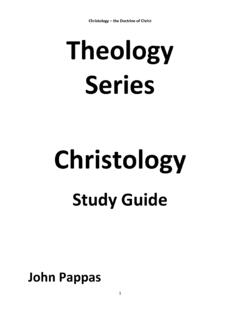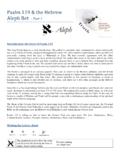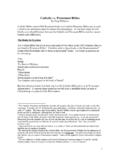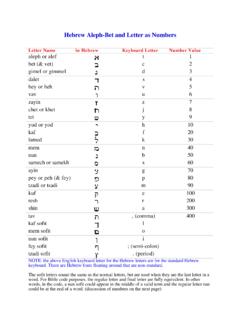Transcription of Biblical Hebrew Basic Grammar of the Hebrew Old Testament
1 I Biblical Hebrew Basic Grammar of the Hebrew Old Testament John Pappas A companion book for the Biblical Hebrew VPOD Internet Video Instruction Program ii Copyright, 2018 by John Pappas, , 3 Table of Contents THE METHOD .. 6 THE STORY OF Hebrew .. 7 THE Hebrew ALPHABET .. 12 THE Hebrew NOUN .. 19 THE NOUN PREFIXES .. 24 THE ADJECTIVE .. 31 PREPOSITIONS .. 35 PRONOUNS .. 39 Hebrew SUFFIXES .. 43 CONSTRUCT 49 INTRODUCTION TO VERBS .. 55 QAL PERFECT STRONG VERBS .. 60 QAL IMPERFECT STRONG VERBS .. 64 QAL IMPERATIVE & PRONOMINAL SUFFIXES OF STRONG VERBS .. 68 QAL INFINITIVE STRONG VERBS .. 72 QAL PARTICIPLE STRONG VERBS .. 75 NIPH AL STRONG VERBS .. 79 PI EL STRONG VERBS .. 85 PU AL STRONG VERBS .. 90 HITHPA EL STRONG VERBS .. 93 HIF IL STRONG VERBS .. 98 HOF AL STRONG VERBS .. 102 THE Hebrew SENTENCE .. 105 FIRST GUTTURAL WEAK VERBS.
2 113 SECOND GUTTURAL WEAK VERBS .. 117 THIRD GUTTURAL WEAK VERBS .. 120 THIRD ALEF GUTTURAL WEAK VERBS .. 123 THIRD HE GUTTURAL WEAK VERBS .. 126 FIRST NUN GUTTURAL WEAK VERBS .. 129 SECOND VAV/YOD GUTTURAL WEAK VERBS .. 131 FIRST VAV OR FIRST YOD GUTTURAL WEAK VERBS .. 134 4 GEMINATE GUTTURAL WEAK VERBS .. 137 APPENDIX .. 139 VERB CHART STRONG VERB .. 140 VERB CHART 2 I-GUTTURAL [PE GUTTURAL (P )] .. 142 VERB CHART 3 I- ALEF [PE ALEF] .. 144 VERB CHART 4 II-GUTTURAL [ AYIN GUTTURAL] .. 146 VERB CHART 5 III-GUTTURAL [LAMED GUTTURAL] .. 148 VERB CHART 6 III- ALEF [LAMED ALEF] .. 150 VERB CHART 7 III-HE [LAMED HE] .. 152 VERB CHART 8 I-NUN [PE NUN] .. 154 VERB CHART 9 II-VAV/ II-YOD [ AYIN VAV/ AYIN YOD] .. 156 VERB CHART 9 II-VAV/II-YOD [ AYIN VAV/ AYIN YOD] CONTINUED .. 157 VERB CHART 10 I-VAV/I-YOD [PE VAV/PE YOD] .. 159 VERB CHART 11 GEMINATE [DOUBLE AYIN].
3 161 DICTIONARY OF Grammar TERMS .. 163 ANSWERS TO QUESTIONS .. 165 VOCABULARY .. 181 5 Preface Since the work done on the Bible Greek VPOD program is behind me, the reflection on and improvements considered are now made to the study of Hebrew . The Basic idea is the same Keep It Simple! That is the primary goal of any first year language study and Hebew needs that same treatment. While keeping it simple, I have tried to also keep the complexity inherent with Hebrew as every Grammar includes multiple complex grammatical terms for what should be one simple term. This simplification is often a hard thing to accomplish since the first year student also needs to get aquanted with the technical terms yet at the same time not be lost because of an unrelated expression. I must thank my Hebrew teacher, David Austin at Tyndale Seminary, Fort Worth, for his encouragement with both Hebrew and Greek.
4 Also my doctrinal advisor and mentor Dr. Mal Couch who spent countless hours discussing language, theology, and life issues. They instilled in me the keep it simple, philosophy that I, in turn, emphisize to my students. It is my hope that the student of this Hebrew Grammar will find the complex made simple, while expanding in knowledge and understanding of the original Jewish author s meaning. That is the goal. It is not possible to interpret completely the thoughts of the original author without going to the original author s language. That means going back to the Hebrew and Greek. Just having a cursory knowledge of the original language helps greatly in the understanding of the Word. 6 The Method The method used for learning the Hebrew of the Old Testament is based on the internet video Bible Hebrew VPOD produced by the author. This program is based on the three fundamentals: Chapter reading of the Grammar book Video instruction using the Hebrew video lessons Then, back to the book for practice and exercises This method is simple, straight to the point, and proven.
5 It is the purpose of this method and program that the student will gain a quick understanding and confidence working with the language while the love and value of it grows. Working the practice exercises is extremely valuable. There is no substitute for memorizing the vocabulary and translating the verses. The volume of words to memorize for each lesson is manageable, and the translation work limited to five or six verses. The selection is made in order for the student to become experienced in the subject of the chapter. The verses were selected for the most part because of their doctrinal meat not just verses for practice sake. Use a Bible, in fact several versions of the Bible when translating so as to get acquainted with variations. Do not get hung up on the variations just do the Basic translation work and wait until intermediate Hebrew to understand the variations.
6 May your time be spent in the Word, not around the Word. May the riches and depths of His Word bless you greatly. 7 Chapter One The Story of Hebrew Hebrew is the language of Abraham, Isaac, and Jacob. Hebrew was the language of the Hebrews of the Egyptian bondage. Hebrew was the language the LORD Himself carved on stone tablets and gave to Moses on Mount Sinai. Technically, Hebrew is one of the Semitic languages categorized as West Semitic which includes the ancient languages of Ugaritic, Phoenician, and Canaanite. Was Hebrew the original language of mankind? We cannot say, but we can say the Hebrew found in the Old Testament was not the original since it was written from around 1450 to 400 The earliest forms of a written language can be dated to around 3500 B. C. in the Near Eastern region of Sumer. And it is interesting to find archeological evidence to support the Biblical account of the separation of languages (Gen.)
7 11). Dr. Henry Morris provides a quote from Ralph Linton, one of the foremost anthropologists who says, Writing was also a Near Eastern invention and one whose contribution to civilization has been even greater than that of metal .. Writing appears almost simultaneously some 5000-6000 years ago in Egypt, Mesopotamia, and the Indus Valley. 1 . It should be noted that even though one finds the written record of Sumer earlier than the written record of Hebrew , that in itself does not prove Hebrew did not exist as a distinct language at the same time. It only says the Hebrew dialect either was not a written language at the time of Sumer, or that Hebrew may have been a fully developed written language but without the societal dominance that Sumer experienced with all its preserved clay tablets. The ancient Semitic division of languages includes the following four divisions: Eastern Semitic: Akkadian, Assyrian & Babylonian Southern: Arabic & Ethiopic Northern: Amorite & Aramaic Northwestern: Canaanite, Hebrew , Ugaritic & Phoenician Within the northwestern Semitic division, the Canaanite division is the main category where all the dialects of the region are classified.
8 The primary north Canaanite dialect is Ugaritic of ancient Ugarit containing a thirty character alphabet and of which much is known due to the large volume of clay tablets describing a rich culture of law, history, religion, business, and epic poetry. The Moabite dialect of northwestern Canaan dates from 840 Our understanding of the Moabites apart from the Biblical record comes primarily from the Mesha Stone. The stone identified with the Moabite king Mesha tells how Chemosh, the god of Moab, had been angry with his people and had allowed them to be subjugated to 1 Henry Morris, Scientific Creationism (Green Forest: Master Books, 2003), p. 193 8 Israel, but Chemosh returned and assisted Mesha to defeat Israel and restore the land to Moab. The stone describes many of Mesha s building projects. The northern coastal region of Canaan was dominated by the Phoenician dialect.
9 This was the region of Tyre, Sidon, Berytus, Tripolis and Byblos, involving all the foreign emigrants from Cyprus, Sicily, and North Africa. The Phoenician dialect becomes more important for the 5th to 2nd centuries BC. Script The script of Hebrew has developed from what is called the Early Hebrew through the generation to what is called the Square Hebrew . The Early Hebrew alphabet is the original script of the Hebrew Bible up to the pre-exilic writings. There was developed among the scribes a cursive script which served the scribe s quick flowing hand. It is the time of the Babylonian captivity that the square script moves to the Hebrew alphabet. Thought to be derived from the Aramaic script, the Hebrew developed into a distinctive Jewish type of While the square script was the most significant development of the Hebrew text, the second most important development was the vowel pointing.
10 Hebrew developed with a consonant only system wherein one knew how to pronounce the vowel sound of the word based on tradition and some Basic rules. A verb had an a vowel sound, while a noun possessed an e sound. During the Babylonian captivity the Hebrew almost lost their language but was somewhat restored, at least in Jerusalem, during the return. But it was in the midst of the great diaspora, between 600-950, that the Jewish scholars, the Masoretes, developed the vowel pointing system in an effort to preserve the original sound. What we have today in the original Hebrew text is not original but from the tradition of the Masorites. Important Early Documents Many Early Hebrew inscriptions, seals, coins, & etc. have been found that have helped us understand the early period of Hebrew . Many of these artifacts are dated to the time of King David, around 1000 Of particular importance are the biblically related works, but also the extra- Biblical works, namely, (1) the Gezer Calendar, a schoolboy s exercise on a clay tablet dated to about 925 describing eight months of the agricultural activity.






